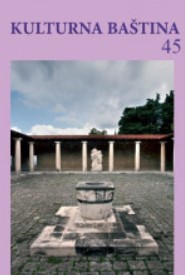UČESTALOST UPORABE IMENA DUJAM / DUJE / DUJKA U TROGIRU
THE FREQUENCY OF THE USE OF THE PERSONAL NAMES DUJAM/DUJE/DUJKA IN THE TOWN OF TROGIR
Author(s): Fani Celio CegaSubject(s): Christian Theology and Religion, Cultural history, Local History / Microhistory, Cultural Anthropology / Ethnology, 6th to 12th Centuries, 18th Century
Published by: DRUŠTVO PRIJATELJA KULTURNE BAŠTINE - SPLIT
Keywords: Dujam; Trogir; names;
Summary/Abstract: Saint Dujam (eng. Domnius), although a patron saint of the city of Split, is also revered in the town of Trogir, thus honoring the Early Christian tradition. According to this tradition, the first Christians congregated in the vicinity of the southern town gates. It was no surprise, thus, when the remains of the simple rectangular-shaped old Church of St. Domnius were unearthed below the foundations of St. Nicholas’ Church, within the St. Nicholas Benedictine convent, during archeological excavations undertaken at the end of the 20th century. Ivan Lucić refers to a document dating from 1064, in which the townsfolk of Trogir gave the nuns of St. Domnius the small church of St. Domnius next to the Lord’s Gate (Porta Dominica), at the urging of Bishop Ivan, the town’s patron. It is one of the oldest churches which existed, alongside St. John the Baptist and St. Leo churhes, before the settlement was ravaged by the Saracens in 1123 and by the Venetians in 1171. Around the time of the abbess Strija in 1194, the monastery and the church were consecrated to St. Domnius and St. Nicholas, and in time only St. Nicholas remained as the church’s name. The memory of St. Domnius was also preserved through Trogir’s artistic heritage, that is, in numerous paintings preserved in the church collections. A valuable holding of the Trogir City Museum’s Garagnin-Fanfogna Library, among other books thematizing St. Domnius, is the book Missae propriae trium santorum patronum metropolitanae ecclesiae Spalatensis, published in Venice in 1690, with a colored copper-plate engraving on its cover, depicting St. Domnius. For centuries Trogir families have kept the custom of naming their children after St. Dominus – Duje / Dujam / Dujka. Aristocratic families such as the Celio Cega family still keep the custom to this very day, while having in mind their Trogir and Split origins, as Thomas the Archdeacon tells us in his chronicles. We also come across the name Dujam in other social classes of Trogir, including of course the members of fraternities. Let us not forget that Trogir-born Ivan Luka Garagnin, after serving as Bishop of the town of Rab, was appointed the Archbishop of Split in 1765. While serving in this function he would be remembered for arranging the completion of the new chapel consecrated to the city’s patron saint, and for taking care that St. Domnius’ relics were transferred, in a formal ceremony, to a chest on the new Baroque altar in 1770, built by the Venetian sculptor Giovanni Maria Morlaiter (1699-1781). Lyrics written in honor of Archbishop Garagnin are preserved in a manuscript dating from the late 18th century, and kept at the Trogir City Museum / the Garagnin-Fanfogna Library. In the Library there are also a couple of books on the life and role of St. Domnius. All of this proves that St. Domnius had his place in the religious, as well as secular life of Trogir. Although his memory faded with the passage of time, St. Domnius was never entirely forgotten, and today the people of Trogir join the people of Split in the festivities on St. Domnius Day.
Journal: KULTURNA BAŠTINA : ČASOPIS ZA PITANJA PROŠLOSTI SPLITSKOGA PODRUČJA
- Issue Year: 2019
- Issue No: 45
- Page Range: 79-90
- Page Count: 12
- Language: Croatian

